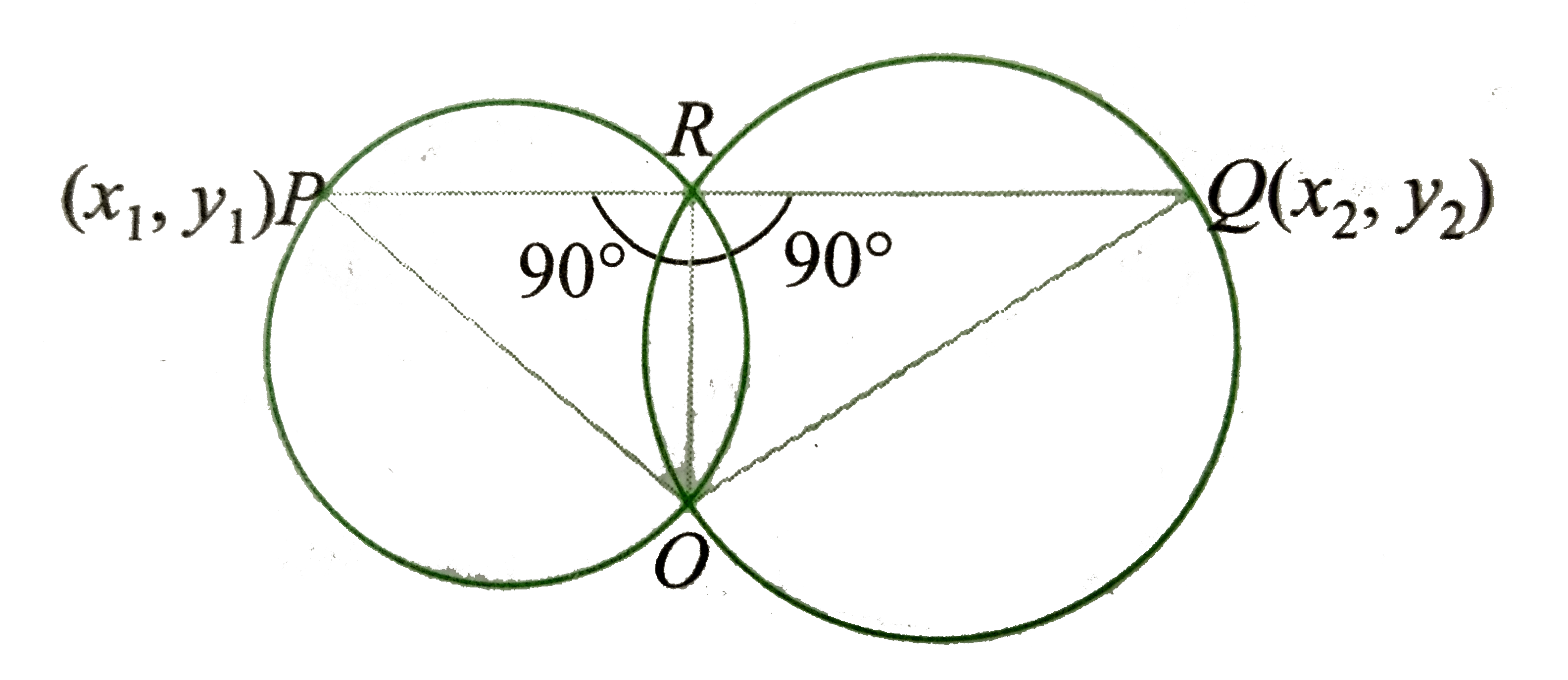The coordinates of two points PandQ are (x1,y1)and(x2,y2)andO is the origin. If the circles are described on OPandOQ as diameters, then the length of their common chord is (a)|x1y2+x2y1|PQ (b) |x1y2−x2y1|PQ |x1x2+y1y2|PQ (d) |x1x2−y1y2|PQ
|x1y2+x2y1|PQ
|x1y2−x2y1|PQ
|x1x2−y2y1|PQ
|x1x2+y2y1|PQ
The correct Answer is:2
OR=2×area of ΔOPQPQ
=2×∣∣12(x1y2−x2y1)∣∣PQ=|x1y2−x2y1|PQ

Topper's Solved these Questions
- CIRCLE BOOK - CENGAGE PUBLICATIONCHAPTER - CIRCLE EXERCISE - Multiple Correct Anser Type
29 Videos
- CIRCLE BOOK - CENGAGE PUBLICATIONCHAPTER - CIRCLE EXERCISE - Linked Comprehension Type (For Problem 1-3)
3 Videos
- CIRCLE BOOK - CENGAGE PUBLICATIONCHAPTER - CIRCLE EXERCISE - CONCEPT APPLICATION EXERCISE 4.17
2 Videos
- BINOMIAL THEOREMBOOK - CENGAGE PUBLICATIONCHAPTER - BINOMIAL THEOREMEXERCISE - Comprehension
11 Videos
- CIRCLESBOOK - CENGAGE PUBLICATIONCHAPTER - CIRCLESEXERCISE - Comprehension Type
8 Videos
Similar Questions
The coordinates of two points PandQ are (x1,y1)and(x2,y2)andO is the origin. If the circles are described on OPandOQ as diameters, then the length of their common chord is |x1y2+x2y1|PQ (b) |x1y2−x2y1|PQ |x1x2+y1y2|PQ (d) |x1x2−y1y2|PQ
View SolutionThe coordinates of two points PandQ are (x1,y1)and(x2,y2)andO is the origin. If the circles are described on OPandOQ as diameters, then the length of their common chord is |x1y2+x2y1|PQ (b) |x1y2−x2y1|PQ |x1x2+y1y2|PQ (d) |x1x2−y1y2|PQ
View Solution
Knowledge Check
The coordinate of two points P and Q are (x1,y1) and (x2,y2) and O is the origin. If the circles are described on OP and OQ as diameters, then the length of their common chord is
A|x1y2+x2y1|PQB|x1y2−x2y1|PQC|x1x2−y2y1|PQD|x1x2+y2y1|PQ
If the coordinates of any two points Q1andQ2 are (x1,y1) and (x2,y2), respectively, then prove that OQ1×OQ2cos(∠Q1OQ2)=x1x−2+y−1y2, whose O is the origin.
View SolutionIf the coordinates of any two points Q1andQ2 are (x1,y1) and (x2,y2), respectively, then prove that OQ1×OQ2cos(∠Q1OQ2)=x1x−2+y−1y2, whose O is the origin.
View SolutionIf the line segment joining the points P(x1,y1)and Q(x2,y2) subtends an angle α at the origin O, prove that : OP.OQ cosα=x1x2+y1y2.
View SolutionIf the line segment joining the points P(x1,y1)and Q(x2,y2) subtends an angle α at the origin O, prove that : OP.OQ cosα=x1x2+y1y2.
View SolutionFind the distance between P(x1, y1)and Q(x2,y2) when i. PQ is parallel to the y-axis ii. PQ is parallel to the x-axis.
View SolutionIf the points P(h,k), Q(x1,y1)and R(x2,y2) lie on a line. Show that: (h−x1)(y2−y1)=(k−y1)(x2−x1).
View SolutionThe ratio in which the line segment joining P(x1, y1) and Q(x2, y2) is divided by x-axis is y1:y2 (b) y1:y2 (c) x1:x2 (d) x1:x2
View Solution
